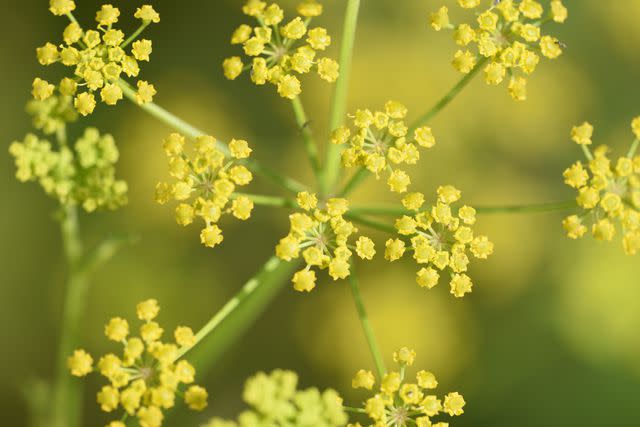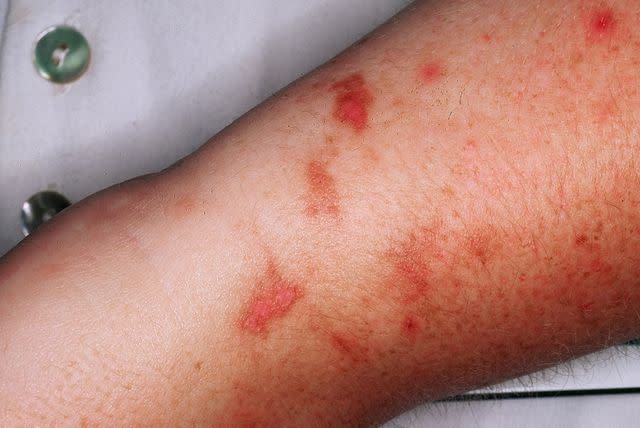Wild Parsnip Burns: Everything You Need to Know
Medically reviewed by Susan Bard, MD
Wild parsnip (Pastinaca sativa) is an invasive plant species with sap that can cause blistering skin burns when activated by sunlight. The clear sap inside this plant's hollow stem contains furocoumarins, which can cause a sunburn-like skin rash called phytophotodermatitis.
Wild parsnip burns can occur if sap leaks out of the plant's tissue when a lawn mower or weed-whacking string trimmer cuts its stems and wet sap makes skin contact. If poison parsnip sap touches the epidermis (outermost layer of skin), and the plant's furocoumarins are subsequently activated by the sun's ultraviolet (UV) light, it can cause a photosensitivity reaction (i.e., a rash).
Read on to learn everything you need to know about why wild parsnip sap burns the skin, ways to prevent getting a poison parsnip rash, what to do if you accidentally come in contact with wild parsnip sap, how to treat varying degrees of wild parsnip burns, and more.

Albert Fertl / Getty Images
What Exactly Is Phytophotodermatitis?

Reproduced with permission from ©DermNet www.dermnetnz.org 2023.
Phytophotodermatitis is a skin reaction caused by contact with a plant containing light-activated chemical compounds. When the sap inside a wild parsnip plant comes into contact with your skin and is subsequently activated by UV rays from sunlight, it can cause severe chemical burns. Unlike poison ivy, which causes an allergic reaction, wild parsnip sap literally burns the skin when it's activated by sunlight.
Because wild parsnip burn symptoms are often delayed by 36 to 72 hours after sunlight activates furocoumarins on photosensitized patches of skin where the sap made contact, phytophotodermatitis from these noxious weeds can be puzzling for diagnosticians and is often misdiagnosed.
Wild parsnip burns may be mistaken for a streak of severe sunburn caused by failing to apply sunblock to a random skin patch before heading to the beach or could look as if scalding hot oil splashed out of a fryer and caused blotchy burns wherever it made skin contact.
Phytophotodermatitis is also called "margarita burn" because people in warm, sunny climates who hand-squeeze limes to make margaritas may experience a skin reaction wherever lime juice lingers on a skin surface that's subsequently exposed to the sun's UVA radiation.
For example, if lime juice drips down someone's arm and then interacts with UVA sunlight, phytophotodermatitis would create a trail of "margarita burn" precisely where the lime juice had streamed down the arm. Squeezing a lemon into iced tea could cause tiny spots of phytophotodermatitis on your fingers, hands, or forearm if droplets of lemon spritz dried on your skin while sitting in the sun.
Similarly, a handprint of phytophotodermatitis could appear on your upper leg if you squeezed lemons or limes, put your hand on your thigh, and went in the sun. Wild parsnip sap works the same way. Any skin area this phototoxic sap touches becomes hypersensitive to sunlight. Wild parsnip chemical burns occur when UVA light activates the furocoumarins in sap-touched patches of skin.
What Does Wild Parsnip Look Like?
Wild parsnip is part of the carrot, celery, and parsley family known as Umbelliferae or Apiaceae, meaning the underside of its leaves have "ribs" similar to those on the underside of an umbrella. It has a hollow, ridged stem that's filled with phototoxic sap.
In its first year, wild parsnip doesn't grow above a knee-high height and can be distinguished by its flat, celery-like leaves. It may have a few small yellow flowers on top when it blooms during summer. In its second year, wild parsnip can grow up to 5 feet tall and is often easily spotted along roadsides and railroad track beds when its distinctive, bright yellow flowers bloom from May to August.
Symptoms of Wild Parsnip Burns
Wild parsnip burns are caused by the sun’s UV light burning the skin in localized areas that had direct contact with this plant’s phototoxic sap. The rash often looks blotchy or streaked and shares symptoms associated with intense sunburn, including:
Redness
Painful burning sensation
Swelling
Inflammation
Tenderness
Rawness
Blistering
Itchiness (pruritus)
Hyperpigmentation (after the rash subsides)
Some people are more sensitive to sun-activated skin burns from wild parsnip sap than others. Symptoms may appear about 12 to 24 hours after exposure but can take up to a week to fully develop.
Wild parsnip rash usually starts out looking red and inflamed. Blisters may form in the first week and can take several weeks to heal. After acute symptoms subside, the affected skin areas may look darker; this hyperpigmentation can last for months or years. Wild parsnip burns can cause scars.
How to Treat Wild Parsnip Burns
Wild parsnip sap can cause first- or second-degree burns. There isn't a cure for wild parsnip burns, but the symptoms can usually be alleviated with common first-aid measures and home remedies for treating varying degrees of burns.
For a first-degree wild parsnip burn, the following home remedies can help treat symptoms:
Cool the skin with chilly (54 to 64 degrees) running tap water for a full 20 minutes.
Use a cold compress (do not use ice!)
Don't wash burned areas with harsh bar soap
Antibiotic ointments can help prevent bacterial infections
Cover any affected areas with gauze or nonstick bandages
Take OTC anti-inflammatory pain relievers such as Advil (ibuprofen) if you're in pain.
Before starting any of these treatments, make sure all the wild parsnip sap has been removed and that the skin is thoroughly cleansed with mild soap and warm (not hot) water. If phototoxic sap remains on the skin, it can get smeared around when applying first-aid ointments, potentially expanding the affected area.
To treat second-degree wild parsnip burns, follow all the first-degree burn steps listed above while taking care not to puncture or "pop" any blisters. Using a cool compress that's been soaked in a Domeboro rash-relief powder can help dry out weeping blisters and reduce itchiness.
Speak to a healthcare provider about using a topical steroid to manage excessive inflammation or applying prescription-only Silvadene cream (silver sulfadiazine), an antimicrobial for preventing severe burn wounds from getting infected. Seek medical treatment if you have a first- or second-degree wild parsnip burn that doesn't respond to home remedies or if broken blisters lead to a skin infection.
Where Does Wild Parsnip Grow?
Wild parsnip commonly grows in sunny areas along the side of public roadways, railroad track beds, and nature paths. Wild parsnip doesn’t grow in shady areas, but it's a resilient weed that can invade old fields, pastures, and prairies regardless of whether the soil is dry, wet, or has well-balanced (mesic) moisture content.
What to Do if You Come in Contact With Wild Parsnip
Upon realizing that your skin has come in contact with wild parsnip, immediately cover the area with a fabric that blocks UV light while making sure not to smudge or smear the sap around on your skin. Get inside as quickly as possible and wash your skin thoroughly with soap and water. If possible, avoid abundant UV exposure for the next day or so.
Get Inside, Wash It Off
Even the smallest drop of wild parsnip sap on your skin should be micromanaged like a biohazardous substance that can spread like a contagion. If you’re in the sun, never smear droplets of wet sap across your skin or let it dry and fully absorb into it. Get inside and wash it off ASAP.
When wild parsnip is weed-whacked with a string trimmer or mowed, the sap can splatter everywhere. Remember to wash all fabrics that come in contact with wild parsnip sap on a heavy-duty cycle to remove any residual phototoxic compounds and avoid future cross-contamination. Also, make sure any equipment or tools that come in contact with wild parsnip's "inner juices" are rinsed off thoroughly after exposure.
How to Prevent Wild Parsnip Burns
Always wear protective coverings such as gloves, a long-sleeve shirt, pants, and goggles if you plan to be weeding or mowing wild parsnip plants. Also, wear sunscreen or sunblock to minimize your skin's photosensitivity.
Although wild parsnips' yellow umbrella of flowers is easy to spot, those that have been mowed and left on the side of the road or along pathways at a highway rest area can be easily missed. In summer months, when wild parsnips' phototoxic compounds are most robust, steer clear of any area that looks like it has freshly mowed weeds lying on the ground.
Summary
Wild parsnip is a weed with poisonous sap that often grows along roads and paths. When it blooms in summertime, it has pretty yellow flowers and can grow up to 5 feet tall. Never pick these yellow wildflowers. When wild parsnip stems are broken, the liquid sap that oozes out can burn your skin if sunlight hits any body area that's come in contact with wet droplets of sap.
The good news is that wild parsnip sap needs sunlight to activate. After exposure, remember to get out of the sun immediately and wash everything that's come in contact with it before heading out into the sunshine again.
Read the original article on Verywell Health.

